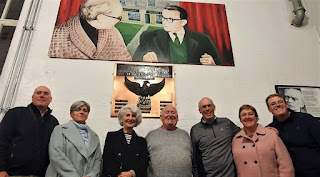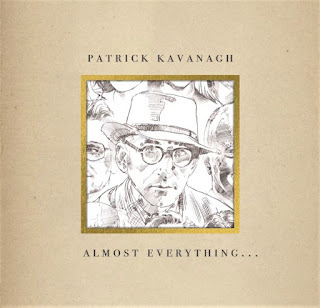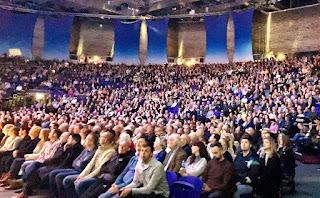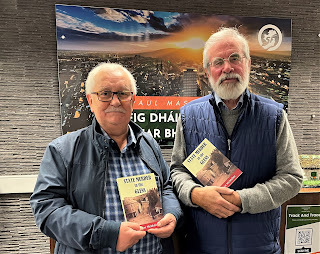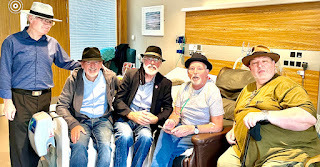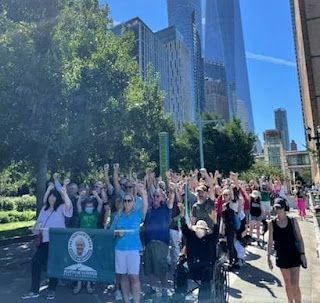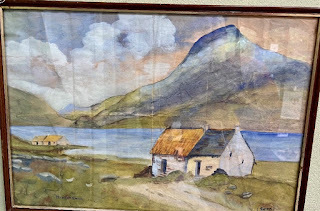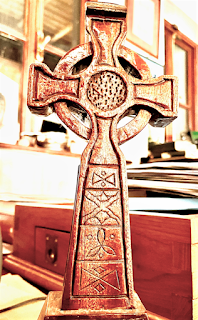Gerry Adams's Blog, page 15
November 8, 2022
Good Advice?: The Climate Emergency: Well done Lula
Good Advice?
I thought I might pass on a random sample of some of the personal advice I have been given over the years. You dear reader might, like me, benefit from some of it. Or perhaps not.
‘If you get arrested say nothing. Sign nothing. Ask for your solicitor. I’ll be there.’ PJ McGrory human rights lawyer and my solicitor for decades.
‘Dont get arrested’ Joe Cahill. August 1971.
‘The least said the soonest mended’. My mother.
‘Always be on time’ Rita O Hare.
‘Dont say a word about anyone else’s children when you’re rearing chidren of your own’. Maggie McArdle.
‘Beware the hoof of the horse, the horn of the bull and the smile of the Englishman’. Fonsai Ó Muruchú
‘Use your head. Your feet’s for dancing’ Cleaky Clarke.
‘Dont let the old man in’ Martin Ferris, 2021.
‘Face the bloody Póc Out’ Gerry Begley.
‘The potato is the most versitile vegetable. There are so many things you can do with it.’ Ted
‘Never miss the opportunity for a pee’. Paul O Dwyer, New York based human rights lawyer and proud Irish republican.
‘Put honey in your porridge’ Martin McGuinness . A JB (O Hagan) Special.
The Climate Emergency
This weekend the United Nations Climate Change Conference (COP 27 – the Conference of the Parties) will begin in Sharm El Sheikh, in Egypt. It will be the 27th UN Climate Change conference and last for 12 days
It comes at a critical juncture in the effort to tackle climate change and follows the publication of three keynote reports by UN agencies warning that we are on the cusp of climatic changes from which there is little prospect of recovery.
Last week I wrote about the drought and famine devastating millions of lives in Somalia in East Africa. The images are frightening. This is the fifth year there has been no rainy season and the experts are predicting that next year’s rainy season, due to begin in March, will fail also. That means an estimated 22 million people are at risk of dying from hunger in Somalia, Ethiopia and Kenya as crops fail again.
There are many factors responsible for this human catastrophe - political, regional, economic, societal, and financial - but the greatest is climate change and the failure of the industrialised states to take the steps necessary to reduce the damage being done by the climate emergency.
This year heat waves in Europe broke temperature records and caused widespread damage. Over 50,000 Europeans died from heat stress, forced thousands more to evacuate their homes and adversely impacted on food production. Spain alone estimated that there were almost 4,000 excess deaths as a result of the heat wave. It is generally accepted that while there have been heat waves in Europe before climate change means that they are increasing in their frequency and intensity.
There have also been devastating floods in Pakistan which left millions homeless; heat waves in India and Pakistan; a heat wave and drought in China; excessive high temperatures in the USA with wildfires causing huge damage; a heat wave in the Middle East; floods in Sudan and South Sudan; the bushfire season in Australia now lasts month longer; and in June Bangladesh face its worst floods in over 100 years.
Most of those who face the human cost of climate change are in regions of the world that have in reality contributed least to it. It is the behaviour of industrialised nations that have contributed most and it is their refusal to honour commitments made at previous Climate Change conferences that now place our planet in peril. The G20 industrialised nations are responsible for 80% of greenhouse gas emissions. The three United Nations reports published in recent weeks underline this reality.
The UN's climate scientists, the Intergovernmental Panel on Climate Change (IPCC), have said that should temperatures rise to 1.7c-1.8C that half the world's population could be exposed to life-threatening heat and humidity. The danger is of a world facing extreme weather conditions, rising sea levels, and as the UN concluded itself, “endless suffering.”
It is also important to note that as millions face food insecurity and millions more are confronted by a cost of living crisis the global oil and gas multi-nationals are raking in the money. Last week Shell reported its second highest quarterly profit on record. It made nine and a half billion dollars in profit between July and September. TotalEnergies made almost 10 billion in profit in the same period. The oil and gas sector is expected to amass four trillion dollars this year. That would be enough to end the climate emergency if used and invested properly. But oil and gas multi-nationals are unlikely to do what’s right to save the planet and save millions of lives.
The onus is on all of us as individuals and on political activists to act speedily to increase pressure on governments and multi-nationals to act responsibly and compassionately. COP 27 needs to produce an emergency series of measures that will more quickly wind down fossil fuel use, invest in green energy and new technology and reduce harmful emissions. Governments also need to introduce a meaningful windfall tax that raises the resources needed to make a difference. In Britain the Shell company has successfully avoided a windfall tax this year by claiming that its investments in that economy mean it has made no profit and consequently has no windfall tax to pay. This should not be allowed in any state.
U.N. Secretary General António Guterres pulled no punches in urging governments to attend COP 27 and to honour commitments already made. He said: “There has been a tendency to put climate change on the back burner. If we are not able to reverse the present trend, we will be doomed."
The people of Somalia and East Africa and the estimated 345 million people around the world who are going hungry today are already doomed. Unless we act to save them.
Well Done Lula.
The successful election in Brazil of former President Luiz Inácio Lula da Silva (popularly called Lula) has raised hopes that the huge damage being done to the Amazon rain forest and the threat to the indigenous peoples of that region will now end. The election was a fraught affair and the strength of both candidates will test the Brazilian democracy in the time ahead. I wish the people of Brazil and President Lula well.
October 31, 2022
Conway Mill celebrates 40th birthday; The tragedy of Somalia; I don't hate Bono
241022
Fra McCann with the family of Fr. Des below a mural of Fr. Des and Frank Cahill
Conway Mill – 40th birthday
Conway Mill has been at the heart of west Belfast for over almost 200 years. First as a hard place of work for generations of local people, mainly women, and then as a community hub providing education and employment opportunities. Last week the Mill celebrated its 40th birthday promoting, supporting and facilitating small indigenous economic enterprises, and providing adult education facilities
Conway Mill was built in 1842, in the decade of An Gorta Mór when thousands fled hunger across Ulster and the West, and came to Belfast seeking work and shelter. Conway Street Mill was one of many flax mills across Belfast. Living and working conditions were dreadful. Hours were long and child labour was prevalent. Workers had no rights. They were hired and fired at the whim of employers.
Following partition many of these hardships as well as the use of sectarianism and segregation were reinforced by the Unionist regime. Life was hard for working people including working class Protestants. In the small back to back streets around Conway Mill overcrowding and poverty were endemic and discrimination against Catholics was widespread. The situation was made worse by the pogroms of 1969 which saw some of the streets and Mills in and around Conway Mill destroyed. By 1970 many of the Mills, including Conway Mill were lying derelict.
 In the early 1980s Tom Cahill came to me with an idea for a unique and innovative project for west Belfast. Tom proposed that Conway Mill should be bought and turned into a community enterprise project providing education, self-help and local employment opportunities. Tom deserves great credit for his vision and foresight. A small businessman himself he could legitimately have developed the Mill in his own interests. I don’t think that even entered his head. Tom’s interest was in this community and its citizens.
In the early 1980s Tom Cahill came to me with an idea for a unique and innovative project for west Belfast. Tom proposed that Conway Mill should be bought and turned into a community enterprise project providing education, self-help and local employment opportunities. Tom deserves great credit for his vision and foresight. A small businessman himself he could legitimately have developed the Mill in his own interests. I don’t think that even entered his head. Tom’s interest was in this community and its citizens.
We organised a management committee which included many well known local republican and community activists, like Frank Cahill, Fr. Des Wilson, Liam Burke, Alfie Hannaway, Jimmy Drumm, Jean McStravick, Sean O’ Neill, Tom Cahill & Colm Bradley.
In 1982 Springhill Community House opened the education floor in the Mill. Noelle Ryan, Elsie Best and other amazing women played pivotal leadership roles. Making it habitable and usable took a great deal of effort. Halla na Saoirse (Freedom Hall) was frequently used for the staging of plays written by local people, including Fr Des. It was also used for debates, conferences, and occasionally for press conferences by Sinn Féin. Some of the most important press conferences during the early days of the peace process were held there.
A crèche was established and staffed by ACE (Action for Community Employment) workers and teachers and tutors were provided by the Workers Educational Association (W.E.A.) and the Ulster Peoples College.
Regrettably Conway Mill became a target for the British state. After the Mill hosted a community led public enquiry into the killing of a young man, John Downes, by a plastic bullet fired by the RUC in August 1984 the Mill was targeted for political vetting and the crèche lost its funding and workers. Businesses and community organisations were told that they would be refused funding if they moved into the Mill.
However the management refused to be coerced or intimidated and continued to fundraise and to develop the Mill. In this they were enormously helped by friends in the USA.
Following the West Belfast and Greater Shankill Task Force report the Mill received substantial funding for regeneration, including from the Office of First and Deputy First Minister.
The official opening of the refurbished Conway Mill in November 2010 was a victory for the determination, vision and courage of that first Management Committee in the difficult years of the 1980’s and all of those who have taken up that task since then.
Along the way, we have lost some who were with us at the start. We are deeply indebted to them all. The story of Conway Mill is the story of this community and of the great sense of solidarity and never giving up that exists in west Belfast. So, well done to all of you who are celebrating 40 years of Conway Mill.
Famine
The history of An Gorta Mór – the Great Hunger – runs deep in the Irish psyche. Few have not read of or heard about the unimaginable horror that the people of Ireland faced during the 1840s. Some label it The Famine although we know that there was sufficient food on the island to feed the people. Political decisions allowed over a million to die and millions more to take to coffin ships for other shores.
So, imagine if today your family, friends and neighbours were facing a desperate struggle for survival with the likelihood that many would be dead from famine by Christmas. That is the stark, brutal reality facing over seven million men, women and children in Somalia.
A decade ago it is thought that more than a quarter of a million Somalis died of hunger. Half were children under five. UNICEF and the World Health Organisation have been warning for months that the situation this time could be much worse.
Climate change has imposed four consecutive years of drought and Somalia now faces a fifth season with no rain. The result is that is in a country with little infrastructure and limited resources over a million people, mainly women carrying young children, have been forced to leave their homes to try to reach emergency centres. The photographs and film images of desperate people and emaciated children and babies is shocking. The accounts of mothers burying their children at the side of roads is deeply disturbing.
Food aid and medicines are an immediate priority but longer term strategies and supports are needed, including rehabilitating water points. There has also been a call for wealthy states to compensate Somalis and others for the catastrophic impact of climate change on their lives. In the UN this is known as “loss and damage financing” and it is on the agenda for the international climate change summit COP27 that is to take place next month in Egypt. In the meantime make your voice heard in demanding greater aid for Somalia.
I don’t hate Bono
Bono - U2’s lead singer has written a book. Surrender 40 Songs One Story. I’m looking forward to reading it.
I understand from press reports that he says his wife Ali and he were targets for the IRA. That’s news to me and I’m sure to anyone else close to republican thinking back in the day. Bono is also quoted in some news reports claiming that I hate him. Nope Paul, not me. You must be mixing me up with someone else. I don’t hate anyone. It’s a wasted negative emotion. I do detest imperialism - a good old fashioned word. Greed. Cruelty. Unbridled capitalism. War. Poverty. I believe in freedom. Solidarity. Equality. Community. Socialism. The Arts.
I think you’re a very fine song writer. I like U2’s music. Always have. And you do have a good voice. The focus you brought to the awfulness inflicted on people in the developing world is commendable. But some of your commentary on the conflict here was shrill, ill informed and unhelpful. However you weren’t on your own. You echoed the Irish establishment line. It was the wrong line for decades. A failure of governance and the abandonment of responsibility to lead a process of peace and justice. Thankfully that changed. But it took a long time.
Despite this some of us got through it all. With or without you. But no hard feelings. Many didn’t. Including friends of mine and family members. Now the conflict is finished. Thanks to all who contributed to that. There is a lot still to be done to remove its causes and to heal the hurt but we will get that done also and shape our own future. We all have a positive role to play in that. By working together. So go well chara. And good luck with the book.
October 17, 2022
Face it Jeffrey: the old days are not returning: Kavanagh’s Anthology a treat: Creeslough
Creeslough: Coming to terms will be so difficult
I know Creeslough well. I have friends who live there. Outside the village. At both ends. My heart goes out to the families of the ten people who were killed last Friday. The brave, generous and determined efforts of neighbours and the emergency services to rescue victims has been exemplary. It is difficult for anyone to come to terms with the random awfulness of this disaster, even from a distance. How much more harrowing and life changing is it for friends and family members? Our thoughts and prayers are with them all.
Go deanfaidh Dia trocaire oraibh.
Face it Jeffrey: the old days are not returning
Last Saturday’s DUP party conference saw it behave as unionist parties have usually behaved. Within their own little bubble.
It’s the same old story. The DUP was established 50 years ago to oppose civil rights. It was openly sectarian. It pledged to Smash Sinn Féin – and failed - founded its own paramilitary organisations and set its face against power sharing. It successfully outmanoeuvred its unionist electoral rivals and emerged triumphant as the largest party in the Assembly. The largest northern party in Westminster. And an ally and confidant of British Prime Ministers. It was all going swimmingly.
Until Brexit. The DUPs support for the Brexit debacle; its willingness to act as a funnel for dark money to bolster the leave campaign in London, and its desire for a hard border on the island of Ireland, have all backfired stupendously. Then there was the Renewable Heating Incentive scandal – with its evidence of gross incompetence and worse within the DUP. Its unwillingness to operate the power sharing institutions in a good faith way also led to serial crises.
None of this came as any great surprise to even a casual observer of unionist politics. From partition the northern state was to be theirs, to do as they chose. To treat non-unionists as they chose. And some DUPers believe that’s the way it should still be.
In 1998 as the Good Friday Agreement was endorsed by the people North and South and opposed by the DUP, I recall warning that there would be a battle a day getting the Agreement implemented. 25 years later and the DUP have effectively collapsed the Executive, the power sharing institutions and the north-south strand of the Agreement. Other key elements of the GFA remain unrealised, including the Bill of Rights. And the Agreement is under threat as never before from the most extreme right wing Tory government since Thatcher.
At the same time the DUP has set aside any concern for households facing a cost of living crisis made worse by that party’s adherence to the madness of Brexit. Families are struggling with increasing bills for oil, electric, gas, and food. As the cold weather arrives pensioners are facing a stark choice between heat and food.
In the midst of this crisis the Executive is unable to take decisions on supports which might mitigate for citizens because of the DUP. It continues to oppose investment in our health system, rejects marriage equality, resists women’s health rights, and the rights of Irish speakers.
Jeffrey Donaldson’s first speech as leader of the DUP last Saturday saw him reiterate all of this. He said: “Let me be clear – either the Prime Minister delivers the provisions of the Protocol Bill by legislation or by negotiation and ensures that our place in the United Kingdom is restored... or there will be no basis to re-enter Stormont.” The bold highlights are Jeffrey’s.
Of course, there has been an electoral cost for the DUP’s obduracy. As a result of its failure to read the electorate and the paucity of its leadership the DUP is no longer the largest party in the Assembly nor do the Unionist parties represent the Assembly majority. Michelle O’Neill is First Minister elect. There are more nationalist MPs than unionist at Westminster. And in the recent census 51% of the population self-identified as Irish/northern Irish. They chose not to identify as British. That figure has dropped to 40%.
Jeffery should be in the Executive and working with the other parties for the people who vote for the DUP and the rest of us. Instead it seems he is looking to an Assembly election to restore the DUPs fortunes and reassert unionist dominance. Mission Impossible my friend. We are all in this together. The days of unionist domination are over.
Kavanagh’s 'Almost Everything' a treat
I am a long time fan of Patrick Kavanagh. And a long time supporter of Claddagh Records. Poet and writer Patrick Kavanagh was born in rural north Monaghan in 1904. He left school at the age of 12 and taught himself about literature. He went on to become one of our leading poets. His early life was steeped in rural ways. He felt, rightly or not, that there was an intellectual barrenness to this existence. “Although the literal idea of the peasant is of a farm labouring person,” he said, “in fact a peasant is all that mass of mankind which lives below a certain level of consciousness. They live in the dark cave of the unconscious and they scream when they see the light.” Though his native area was poor, he felt that “the real poverty was lack of enlightenment,” and he added, “I am afraid this fog of unknowing affected me dreadfully.”
Nobel Laureate Séamus Heaney was influenced by Kavanagh. He was introduced to Kavanagh's work by the writer Michael McLaverty when they taught together at St Thomas's School on the Whiterock Road, in west Belfast. Heaney and Kavanagh both believed that the local could reflect the universal. Heaney said of Kavanagh: “His instruction and example helped us to see an essential difference between what he called the parochial and provincial mentalities". As Kavanagh put it: "All great civilizations are based on the parish". Kavanagh’s poems include; On Raglan Road, A Christmas Child. October. In Memory of My Mother. The Great Hunger. Bluebells are for Love. His novel Tarry Flynn is a gem.
Claddagh Records was founded in 1959 by Garech Browne and his friend Ivor Browne, to record and popularise our indigenous music. Claddagh famously brought us The Chieftains alongside other amazing musicians like Leo Rowstone and Tommy Potts. I still have LPs from that era. Claddagh also recorded Patrick Kavanagh and other poets, including Máire Mhac an tSaoi. Now Claddagh Records has launched Patrick Kavanagh-Almost Everything. It includes Kavanagh himself reading his own work and reflecting on his life. He is joined by a range of other readers including Bono, Liam Neeson, Christy Moore, Hozier, Kathleen Watkins, Michael D’, Jessie Buckley and Sharon Corr. Listening to Kavanagh himself is a special treat.
Garech Browne and others involved were visionaries. He planned for a revival of Claddagh Records and hoped before his death for the rerelease of some of its albums which were in storage at that time. He said “ I would like the recordings to be available to anyone interested in Irish music, poetry and the written word. They are no good to anyone where they are now.”
I am delighted that Claddagh has been relaunched. I am looking forward to the publication of a history of Claddagh Records which Garech Browne was involved with.
James Morrissey, Chairperson of Claddagh Records is centrally involved in these very positive and welcome initiatives. Claddagh have secured a licensing deal with Universal Music Ireland. In an interview with Siobhan Long in The Irish Times Morrissey says the aim is to make Claddagh’s catalogue available everywhere. This is great news. So is the release of Patrick Kavanagh’s Almost Everything. I have often thought that the best way to understand poetry is to read it aloud. Thanks to Claddagh we can now have one of our finest poets, Patrick Kavanagh, doing that for us. If you want to see what’s available check out the link at:
https://claddaghrecords.com/collections/merchandise
Face it Jeffrey: the old days are not returning: Kavanagh’s Anthology a treat: Cresslough
Cresslough: Coming to terms will be so difficult
I know Creeslough well. I have friends who live there. Outside the village. At both ends. My heart goes out to the families of the ten people who were killed last Friday. The brave, generous and determined efforts of neighbours and the emergency services to rescue victims has been exemplary. It is difficult for anyone to come to terms with the random awfulness of this disaster, even from a distance. How much more harrowing and life changing is it for friends and family members? Our thoughts and prayers are with them all.
Go deanfaidh Dia trocaire oraibh.
Face it Jeffrey: the old days are not returning
Last Saturday’s DUP party conference saw it behave as unionist parties have usually behaved. Within their own little bubble.
It’s the same old story. The DUP was established 50 years ago to oppose civil rights. It was openly sectarian. It pledged to Smash Sinn Féin – and failed - founded its own paramilitary organisations and set its face against power sharing. It successfully outmanoeuvred its unionist electoral rivals and emerged triumphant as the largest party in the Assembly. The largest northern party in Westminster. And an ally and confidant of British Prime Ministers. It was all going swimmingly.
Until Brexit. The DUPs support for the Brexit debacle; its willingness to act as a funnel for dark money to bolster the leave campaign in London, and its desire for a hard border on the island of Ireland, have all backfired stupendously. Then there was the Renewable Heating Incentive scandal – with its evidence of gross incompetence and worse within the DUP. Its unwillingness to operate the power sharing institutions in a good faith way also led to serial crises.
None of this came as any great surprise to even a casual observer of unionist politics. From partition the northern state was to be theirs, to do as they chose. To treat non-unionists as they chose. And some DUPers believe that’s the way it should still be.
In 1998 as the Good Friday Agreement was endorsed by the people North and South and opposed by the DUP, I recall warning that there would be a battle a day getting the Agreement implemented. 25 years later and the DUP have effectively collapsed the Executive, the power sharing institutions and the north-south strand of the Agreement. Other key elements of the GFA remain unrealised, including the Bill of Rights. And the Agreement is under threat as never before from the most extreme right wing Tory government since Thatcher.
At the same time the DUP has set aside any concern for households facing a cost of living crisis made worse by that party’s adherence to the madness of Brexit. Families are struggling with increasing bills for oil, electric, gas, and food. As the cold weather arrives pensioners are facing a stark choice between heat and food.
In the midst of this crisis the Executive is unable to take decisions on supports which might mitigate for citizens because of the DUP. It continues to oppose investment in our health system, rejects marriage equality, resists women’s health rights, and the rights of Irish speakers.
Jeffrey Donaldson’s first speech as leader of the DUP last Saturday saw him reiterate all of this. He said: “Let me be clear – either the Prime Minister delivers the provisions of the Protocol Bill by legislation or by negotiation and ensures that our place in the United Kingdom is restored... or there will be no basis to re-enter Stormont.” The bold highlights are Jeffrey’s.
Of course, there has been an electoral cost for the DUP’s obduracy. As a result of its failure to read the electorate and the paucity of its leadership the DUP is no longer the largest party in the Assembly nor do the Unionist parties represent the Assembly majority. Michelle O’Neill is First Minister elect. There are more nationalist MPs than unionist at Westminster. And in the recent census 51% of the population self-identified as Irish/northern Irish. They chose not to identify as British. That figure has dropped to 40%.
Jeffery should be in the Executive and working with the other parties for the people who vote for the DUP and the rest of us. Instead it seems he is looking to an Assembly election to restore the DUPs fortunes and reassert unionist dominance. Mission Impossible my friend. We are all in this together. The days of unionist domination are over.
Kavanagh’s 'Almost Everything' a treat
I am a long time fan of Patrick Kavanagh. And a long time supporter of Claddagh Records. Poet and writer Patrick Kavanagh was born in rural north Monaghan in 1904. He left school at the age of 12 and taught himself about literature. He went on to become one of our leading poets. His early life was steeped in rural ways. He felt, rightly or not, that there was an intellectual barrenness to this existence. “Although the literal idea of the peasant is of a farm labouring person,” he said, “in fact a peasant is all that mass of mankind which lives below a certain level of consciousness. They live in the dark cave of the unconscious and they scream when they see the light.” Though his native area was poor, he felt that “the real poverty was lack of enlightenment,” and he added, “I am afraid this fog of unknowing affected me dreadfully.”
Nobel Laureate Séamus Heaney was influenced by Kavanagh. He was introduced to Kavanagh's work by the writer Michael McLaverty when they taught together at St Thomas's School on the Whiterock Road, in west Belfast. Heaney and Kavanagh both believed that the local could reflect the universal. Heaney said of Kavanagh: “His instruction and example helped us to see an essential difference between what he called the parochial and provincial mentalities". As Kavanagh put it: "All great civilizations are based on the parish". Kavanagh’s poems include; On Raglan Road, A Christmas Child. October. In Memory of My Mother. The Great Hunger. Bluebells are for Love. His novel Tarry Flynn is a gem.
Claddagh Records was founded in 1959 by Garech Browne and his friend Ivor Browne, to record and popularise our indigenous music. Claddagh famously brought us The Chieftains alongside other amazing musicians like Leo Rowstone and Tommy Potts. I still have LPs from that era. Claddagh also recorded Patrick Kavanagh and other poets, including Máire Mhac an tSaoi. Now Claddagh Records has launched Patrick Kavanagh-Almost Everything. It includes Kavanagh himself reading his own work and reflecting on his life. He is joined by a range of other readers including Bono, Liam Neeson, Christy Moore, Hozier, Kathleen Watkins, Michael D’, Jessie Buckley and Sharon Corr. Listening to Kavanagh himself is a special treat.
Garech Browne and others involved were visionaries. He planned for a revival of Claddagh Records and hoped before his death for the rerelease of some of its albums which were in storage at that time. He said “ I would like the recordings to be available to anyone interested in Irish music, poetry and the written word. They are no good to anyone where they are now.”
I am delighted that Claddagh has been relaunched. I am looking forward to the publication of a history of Claddagh Records which Garech Browne was involved with.
James Morrissey, Chairperson of Claddagh Records is centrally involved in these very positive and welcome initiatives. Claddagh have secured a licensing deal with Universal Music Ireland. In an interview with Siobhan Long in The Irish Times Morrissey says the aim is to make Claddagh’s catalogue available everywhere. This is great news. So is the release of Patrick Kavanagh’s Almost Everything. I have often thought that the best way to understand poetry is to read it aloud. Thanks to Claddagh we can now have one of our finest poets, Patrick Kavanagh, doing that for us. If you want to see what’s available check out the link at:
https://claddaghrecords.com/collections/merchandise
October 11, 2022
Belfast Peoples' Assembly: Together we Can: State Murder in the Glens: Lucas
101022
Belfast Peoples Assembly.
Tomorrow evening - Wednesday 12 October - Belfast Sinn Féin will be holding the inaugural meeting of the Peoples' Assemblies organised by the party's Commission on the Future of Ireland.
The series of meetings are about expanding on the conversation on Irish Unity and constitutional change, that is gathering pace.
Registration for the meeting, which is in the Waterfront Studio, is now closed but If you want to continue the discussion on future constitutional change why not make a submission to the Commission.
These can be made online at www.sinnfein.ie/futureofireland
See you in the Waterfront Hall on 12 October.
Together we Can
Ireland’s Future is well named. Its landmark event last Saturday in Dublin was all about the future.
Saturday’s conference was an ambitious project. Over thirty participants addressed 5,000 citizens. Ten political parties with five party leaders along with leaders from civic society and the Arts talking about their desire to achieve a united Ireland. And music and dance as well. That’s a remarkable achievement.
The audience was excited, engaged and respectful. The tiered thousands listened attentively. Applauded enthusiastically. Hope was in the air. It’s good that An Tanaiste Leo Varadkar was there. Unfortunate that An Taoiseach was not.
There were interesting and insightful contributions from those who were unionist and are now on personal journeys of discovery. Ben Collins, Rev Karen Sethuraman, Andrew Clarke and Peter Adair explained why they have moved from unionism to advocating for unity. For Peter Adair it was the Brexit vote in 2016 that opened his mind to other possibilities. Andrew Clarke is for progressive politics on same sex marriage and women’s health and didn’t see his views reflected in political unionism. Ben Collins remarked that he and Rev. Karen Sethuraman are from East Belfast: “we want people from East Belfast to do well …. What we need to point out is that Britain doesn’t really care for Northern Ireland, they don’t want us.”
The final speaker of the day was the actor James Nesbitt who spoke for all in the auditorium when he said that a referendum on unity requires an informed debate. Nesbitt said that solutions must emerge from a public discussion of the options for the future and should be led by the people.
The 3Arena was buzzing as the thousands headed home. If you have been enthused by it then become active. If you’re already active - do more. The Good Friday Agreement, with its provision for a unity referendum and its commitment to defend and protect the rights of all citizens, is the bedrock of the philosophy that drives this movement of United Irelanders.
So well done Ireland’s Future. And thank you.
State Murder in the Glens
It has long been my view that people need to tell their own stories and the stories of their communities. Historians often concentrate on the big events, the big stories and big leaders. These are important but usually the personal accounts of citizens and their individual experiences are ignored.
IRA Volunteers Patrick McVeigh and Charles McAllister were killed in Glenariffe in May 1922 and civilians John Hill, John Gore and James McAllister were murdered in Cushendall in June 1922. The three young men shot dead in Cushendall were victims of the Ulster Special Constabulary – a paramilitary armed unionist force. Unionist paramilitary organisations were recruited almost to a man into the Ulster Special Constabulary of A, B and C Specials – which eventually formed the bulk of the Royal Ulster Constabulary (RUC).
For the first time the terrible events of June 1922 have been researched and published in a new book – State Murder in the Glens - by former Sinn Fein Councillor and MLA Oliver McMullan. It is an insightful, at times disturbing and frightening reminder of the imposition of partition and the brutality involved.
Using state records, some of which were locked away for 75 years, Oliver details the circumstances surrounding each incident, the disgraceful manner in which they were subsequently investigated, the inquiries that were held, the lies that were told, the bias of the courts, the denial of truth and justice to the families and the political cover-up that took place.
Oliver McMullan’s book will be launched on 3 November in Áras Uí Chonghaile.
We buried Óglach Frank Lucas Quigley last week. A very large funeral on a beautiful warm afternoon. There was tears and music – a fine piper and Bik on the feadóg. And songs. Fra McCann was fear an tígh and Danny Morrison excelled himself with a wonderful oration which captured the essence, humanity, humour, bravery and history of Frank and his family especially Jimmy, another Óglach, killed aged eighteen by the British Army fifty years before on the very date of Frank’s funeral. Danny remarks are on social media. Here are a few quotes.
‘Frank, Frankie, Lucas, had a love of life. Indeed, he had a lust for life. And why wouldn’t he, given what he and his family came through.
When Frank was nine his father died. At nineteen Frank was shot. Six months later Jimmy was shot dead. Tommy was imprisoned for life. When Frank was in Portlaoise his infant daughter Aisling was seriously injured in a fall. Later, his eldest son Cormac was attacked and brutally assaulted by a loyalist gang. His youngest son Rossa was critically injured in a car crash and was in a coma for a time. Years later, Rossa was killed by death riders. Two years ago Frank lost his partner, Pat. Earlier this year, Josie, the mother of Cormac, Aisling and Rossa, died of Covid.
It’s a wonder any light shone from Frank given all these blows to him and his family’.
Frank’s mother told Danny once: ‘I often wonder what Jimmy would have ended up working at, how things would have been, Danny, if the Troubles hadn’t come along.’
It’s a thought that every mother has had.
I said: ‘It’s hard to believe that Jimmy is dead thirty years.’
And she said, ‘Jimmy’s forty-eight this year.’
Forty-eight. Because you see, Jimmy, shot dead at eighteen,lived on in the thoughts and on the lips of his mother, his brothers, his friends and comrades - just as Frank will.’
Over a twenty-nine-year period, from 1970 until 1999, Mary Quigley visited her sons in Crumlin Road Prison, the Maidstone, Armagh, the Kesh, Magilligan, Mountjoy and Portlaoise, and the eight jails Tommy was imprisoned in the length and breadth of England until his release under the Good Friday Agreement.
Lord thou are hard on mothers. Mary Quigley was a great woman. I always found her very welcoming and very supportive. She, as much as her sons, fought for a better future for us all. She supported the peace process. So did her warrior son Frank.
He was also fine artist with a grá in recent years for hats. As Tommy said to me he loved dressing up. Here’s a gang of us with him at the hospice weeks before his death.
October 4, 2022
Unravelling the northern state: Last rites
16 September 2022
Unravelling the northern state
Last week’s census figures have generated acres of newsprint and headlines on its detail and implications. It is remarkable that a century after partition, and the creation of this sectarian gerrymandered little statelet, that the population demographics have shifted so dramatically.
While many people today are reluctant to equate religion with political affiliation and national identity it is nonetheless a fact that the northern state was constructed on that basis. Two thirds of the population was Protestant and unionist. One third was Catholic and nationalist. In the years following partition the Unionist regime at Stormont set about entrenching its domination by creating an apartheid state in which Catholics/nationalists were discriminated against in employment and housing and tens of thousands were denied the vote in local government elections.
When the census figures where published ten years ago in December 2012 the unravelling of the sectarian headcount that was the basis for the northern state was already visible. When the question of identity was asked 40% of citizens registered as British-only. Another 8% identified as British and northern Irish. That meant that 48% of citizens in the North had some form of British identity. A far cry from the 66% of 1920.
Those who acknowledged in 2011 that they were Irish-only stood at 25% and the figure for those self-identifying as northern Irish-only was 21%. That was 46% of citizens identifying as Irish and not British.
Ten years later and the percentage identifying as British-only has dropped significantly to 32% while those who registered as British and northern Irish is unchanged at 8%. That means that approximately 40% of citizens now identify as British. The comparison for those identifying as Irish-only shows a jump of 4% to 29%. Those who registered as northern Irish-only has remained unchanged at approximately 20%. In addition another 2% identified as Irish and northern Irish only. That brings the total identifying as Irish to 50.67%.
In addition, in the last six elections in the North political unionism has failed to secure an electoral majority. In every electoral contest since 2017 the combined unionist vote was less than a majority of votes cast. Put simply, the unionist electoral majority is gone.
In the Assembly election Sinn Féin secured the largest number of first preference votes and the largest number of seats - a first for a non unionist party. Michelle O’Neill is now the First Minister Designate. Partition was supposed to make this impossible. Partition sucks. On all counts.
That does not mean that winning the unity referendum is a dead cert or that Irish Unity is inevitable. What it does mean is that there are more and more citizens in the North who want constitutional change. But it must be planned. For united Irelanders this presents an enormous opportunity and a huge challenge.
I was reminded this week of an answer I gave to a question about whether nationalists could breed our way into a united Ireland – “an enjoyable pastime for those with the energy but hardly a political strategy.” I replied. That remains the case. Our future needs planned. By us. Not by London.
This weekend Ireland’s Future is holding a historic conference in Dublin. It is doing what an Irish government should be doing – developing a strategy, encouraging discussion, planning for the future, and holding a conversation about the shape of the new Ireland.
Last Rites
Back in the day I used to be a regular mass goer. Not any more. I have always liked the communal and social aspects of the mass and I am comfortable with the rituals involved. I like other religious services as well. The protestant ones are much more democratic than the catholic ones. But it is hardly surprising that there is a beneficial familiarity about the mass for folks like me given that most Catholics of my age were reared in that tradition. And I like church music. A good choir or solo singer or a hymn that the whole congregation can sing together is very uplifting.
Most chapels or churches are also contemplative spaces. Holy places. And it’s good to be in a space like that on a regular basis. Arguably nature also provides this space. We have lake sides, beaches, glens, mountain scapes, rivers, parks and gardens. Perfect places for us to catch up with ourselves and to meditate. To reflect on the mysteries and meaning of life. I used to do both. Now I mostly do nature. So when I go to mass nowadays, usually for funerals, it is a reminder of simpler days.
In my youth chapels were filled to overflowing. A mass I attended recently had only sixty three people in attendance. I counted them. Most were around my age. The youngest family there were dark skinned. Other young ones, including young people in my own life, are reared in a more secular mode these days. And no harm in that either. Good values are what matter. And no religion has a monopoly on that. In fact some have lost sight of the importance of good values in a maze of man-made rules and bad practice in which the institution reigns supreme and the message is subverted. It’s all about control. In some cases Christ has been erased from Christianity. He embraced sinners, the poor and dispossessed. That’s why they crucified him. And they would do it again.
I have never really been comfortable with ‘Roman’ Catholicism. The 0NE holy catholic bit stuck in my craw even when I was in my early teens. Surely there were/are other churches entitled to respect, not just ONE. Even at school I questioned the position of Rome and our own hierarchy on issues, including its compliant attitude to the status quo here in Ireland. My critical attitude crystallised as I got older in line with my political consciousness. But I persisted with the rites of the church because I thought of it as a popular institution as opposed to a clerical one. The church was bigger than the hierarchy, I reasoned.
And besides over the years I got to know a lot of good priests who shared my broad views. So even when the message from the pulpit really annoyed me during the decades of conflict I never walked out off Mass when the celebrant insulted the congregation although I understand why others did so. I stuck it out. Maybe out of contrariness. Maybe my own understanding of the teachings of Jesus. Maybe because I wouldn’t give in to the hierarchy’s political agenda.
The lack of democracy within the church continued to irk me. This increased as I got older. Especially the refusal to accept women as equals. In fact the misogyny writ large in the official Church’s fixation with sex and the casting of women as mainly to blame for that ‘sin’ became more and more annoying. But it was the revelations about the Tuam babies which finished me. The burial of an estimated 800 infants in a sewage tank was too much. I was sickened by that and the other revelations of wrong doing. And the cover ups and hypocrisy. I know cover ups happen all the time in politics and other spheres and hypocrisy is in the eyes of the beholder but in these cases it was being done in the name of God by people without a mandate or a willingness to discuss any of this. Or to be accountable. Mostly because they claimed these babies were born in sin. So they weren’t worthy of respect. Neither were their mothers. The fathers got off of course.
So I stopped going to weekly mass. When I do go it is obvious that tens of thousands of others have also absented themselves. I always recall the words of Father Des Wilson to myself and Fr Alec Reid many moons ago. We were trying to meet with Catholic Church leaders to discuss building a peace process. With a few honourable exceptions they refused to meet me. I was an MP at the time with a mandate unlike any of them. But they had a mandate from God. They claimed. Or canon law.
‘You know’ Father Des said to us, ‘By the time the bishops agree to meet with the people no one will want to meet with them’.
Father Des was right.
That’s why the church is in the state it’s in today. And while the catholic in me regrets that to a certain extent, it’s no bad thing. A healthy democratic and inclusive society based on rights and tolerance including religious freedoms is more important than any church. The sectarian arrangements foisted on us for far too long encouraged sectarianism and the growth of fundamentalist clerical control. In both parts of our island. A truly democratic dispensation and full empowerment of people will lift us all above all this.
September 18, 2022
Tolerating of Differences: Colm's Harps
Tolerating of Differences
For those of us living in the north of Ireland the English Queen Elizabeth has been omnipresent in our lives for a long time. From our postage stamps, coins and bank notes to the names of our public buildings.
In Belfast there are two bridges named after English Queens. The Queens Bridge was opened in 1849 and is named after Victoria. The Queen Elizabeth Bridge is named after the woman who has just died. It was opened in 1966. Interestingly there was a row among unionists in Belfast City Council who wanted to name it after Unionist leader Edward Carson whose statue stands in front of Parliament Buildings at Stormont.
There is also Royal Avenue and the Royal Victoria Hospital and countless other thoroughfares named after British Royals. There is Queens University and the Albert Clock named after Victoria’s other half.
Royal this and royal that. Everywhere. And this is even before we get to the Crown Forces and all their Royal Regiments or Her Majesty’s Prisons.
Dublin also has its royal remnants. For example, for the almost ten years that I was a TD in the Dáil I parked each day in the shadow of a statue to Prince Albert, the consort of the English Queen Victoria.
Whether we reject or embrace this phenomenon is immaterial. Because Elizabeth has been at the centre of it all for so long she has become a constant in our lives. The current protracted and saturation media coverage adds to this. But the responses to her death are complex and diverse.
Royalists and supporters of the monarchy will be personally affected by Elizabeth’s death. Those of us who don’t share this view need to be aware of it and act accordingly and respectfully. We will also be mindful that Elizabeth’s family have lost a much loved family member. For them this is a heart wrenching moment. Most of us can have empathy at a human level with that. I certainly can. Which is why I sympathise with them.
At the same time I have no time for hierarchies, aristocrats or royalty, whether they are political, religious, secular or industrial. They are all about power for elites. No one should have an entitlement to a life of privilege and wealth because they are deemed to be divine rulers. No one should have the right to rule anyone else unless they are democratically elected. I believe in equality. In community. In solidarity. Citizenship. In self-determination. None of us should ever be anyone’s subject. Working people should always be mindful of our own class and of our own history, our values and entitlements. If I was English I would be an English republican. And a socialist. These are internationalist beliefs. I’m also a democratic. I believe in self-determination.
But I’m Irish. An Irish republican and a socialist. And we Irish should be aware of our own nation with our culture, language, history and customs.
For many reasons we have our own special experience of the English monarchy. It has been a tragic and costly one. For centuries we have been denied our right to govern ourselves. The Empire colonised us and many other people. Across the world and in our own place. Countless crimes were committed globally in the name of the crown. Military interventions into other peoples’ affairs continue.
So those who support the monarchy should be respectful towards those of us who don’t. Just as we should be respectful of their views. We have a lot to learn from each other. Tolerance of differences is a good basis for this.
Society must reflect and include the entirety of its people, not part of them. Inclusivity is vital to the well being of any community, whether a nation, the global village or a local populace.
I acknowledge the attachment that many within the unionist section of our people have for the English royal family and their genuine grief at the death of their Queen. That has rightly been reflected in remarks by Mary Lou McDonald and Michelle O Neill, and Alex Maskey and their comments have been balanced, sincere and respectful.
Queen Elizabeth’s remarks and her important gestures during her visit to the Garden of Remembrance in Dublin in May 2011 and her subsequent meetings with Martin McGuinness were helpful and unprecedented. Although nowadays the willingness of the London government to tear up agreements with and about Ireland - nothing new in this – illustrates the need to go beyond symbolism in the search for new and genuine rapprochement.
Martin McGuinness was firmly of the view that the British royals were strong supporters of the Irish peace process. I agree. He and I met with Charles in May 2015. At our first meeting Martin and I acknowledged the hurt he and his family suffered by the actions of republicans. We were conscious also of the sad loss of the Maxwell family whose son Paul was also killed at Mullaghmore.
We and Charles also discussed the hurt inflicted on my neighbours and my friends in Ballymurphy and Springhill by British crown forces and the killings of Martin’s neighbours and friends in Derry on Bloody Sunday by the regiment of which Charles is commander in chief. We talked about all this and other related matters. Our conversations were important. And genuine.
Charles is now the King of England. He has a responsibility to act on his own words and on the words of his mother as he adapts to his new role.
We are all living in a time of transition for the people of Ireland and between Ireland and Britain. There are huge challenges. They are multiple and immediate. These challenges must be overcome. Just as Alex Maskey, a man who was denied his rights for most of his life; a man who was interned without trial; a man whose homes shot up; a man whose friend was killed in his living room; a man himself who was very seriously wounded and whose wife Liz McKee was the first woman interned. Alex rose to those challenges, to act on behalf of the Assembly in greeting King Charles.
So challenges can be overcome and Charles in fairness overcame his grief and one could say there is reconciliation despite the suffering of the past between Irish republicans and at a personal level the new King as there was before with his mother.
So there are other challenges and they include bringing the current constitutional arrangements gently to an end as set out in the Good Friday Agreement by building a new democratic alternative to the dysfunctional union with Britain. That’s with way for us all to live together in harmony and in respect for each other.
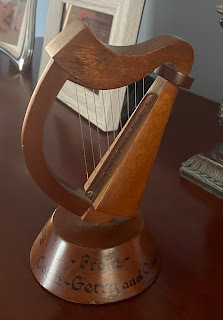
Colm’s Harps
I was very pleased to get an email from Colm Dawson from New York. Colm, who is originally from Belfast, read my article about Long Kesh handicrafts in The Irish Echo.
He writes ‘During internment my mother used to bake homemade soda farls and send them up to the Cages. In 1973, in recognition of her contribution, we received this lovely little harp. I believe it came from Conn McHugh, Owen Quigley and your good self.
It has been sitting in my living room in NY for over twenty years. And it’s in great shape. That wee harp sat on top of our TV in Belfast for decades. We had another one that my dad won in a raffle at the PD, also in 1973, that sat beside it. Both are now here with me.’
Margaret and Mickey Dawson, Colm’s parents, were outstanding supporters of the republican prisoners and champions of our struggle. Míle buiochas Colm. Anyone else with prison memorabilia stories get in touch.
September 13, 2022
Another British PM closer to Unity: On Dangerous Ground: The Chieftain's Walk
Another British PM closer to Unity
Liz Truss is now the leader of the Conservative Party and British Prime Minister. No real surprise there. She is the fourth leader of the Tories in six years. And as each has tried and failed to reshape Britain to a post Brexit world Tory government policy – especially under Johnson - has shifted further and further to the right.
If Truss’s rhetoric during the election contest is to be believed this trend will increase on her watch. The challenges facing Truss are huge. While some arise from the war in Ukraine most are a consequence of the Brexit referendum in 2016 and of policies she promoted while in government.
The devastating impact of Brexit on the British economy has been enormous. There is a shortage of essential workers in agriculture, in the health service and elsewhere in the British economy. The trade deals with non EU countries that Truss has trumpeted as compensating for Brexit have had little effect. The NHS is unable to meet the demands being placed upon it. The miles long lorry queues in Kent are evidence of Brexit’s failure. And there is now the cost of living crisis pushing oil and gas and food prices up to unimaginable levels and driving many citizens deeper into poverty.
So far Truss has refused to outline her policies to meet these challenges. We know that she is for a tougher stance against refugees and is an advocate of the Rwanda policy of sending them to Africa. We know that she wants to scrap Britain’s link with the European Convention on Human Rights – a key element of the Good Friday Agreement. We know that she for tax cuts that will only benefit the wealthy. In essence we know that she is from the Boris Johnson mould of incompetent politics and is set on continuing these.
When it comes to Ireland Truss doesn’t care. Any more than Johnson did. She has indicated a willingness to back the DUP demand for unilaterally triggering Article 16 of the Withdrawal Agreement with the EU. This would see the British breach international law and suspend those elements of the protocol which they and their unionist allies don’t like. Earlier this year Truss introduced the “Northern Ireland Protocol Bill” which if passed by the British Parliament would also allow individual Ministers to scrap the protocol. The Bill is due in the British Lords after the summer recess.
The EU has repeatedly claimed that the British have refused to engage in any serious way in negotiations on the protocol. This approach will continue under Truss as will the chaos and confusion that has marked successive Conservative governments for over a decade. The likely consequences of this for the North and for the island of Ireland and indeed for Scotland, do not look good. But many people’s eyes will be opened. More and more will realise that British government policy has always been dictated by what is in the British – English - interest. Ireland’s interest will never be served by London.
Our response must be to challenge this at every opportunity. The British government has no mandate in Ireland. Only the people of our island have the right to govern ourselves. The sooner the better. No matter what else happens on her watch with Truss’s selection we are another British PM closer to that day.
ON DANGEROUS GROUND.
This is not a book review. It is a book recommendation. On Dangerous Ground is a memoir by Máire Comerford, edited by Hilary Dully, with an introduction by Margaret Ward. It was recently published by Lilliput. ON DANGEROUS GROUND is required reading for all aspiring republican revolutionaries and students particularly of the period from 1916 to the 1920s. From revolution to counter revolution. From the Proclamation of 1916 to partition and civil war.
Máire became a republican activist in 1916. She joined Cumann na mBan and Sinn Féin and she had a full role in many of the events which followed the Rising. She remained an unrepentant republican up to her death in 1982 and kept up a keen involvement in the struggle during all this time. Máire befriended Rita O Hare, Danny Morrison and other activists of our time. Danny gave the oration at Máire’s funeral. She had hoped to have her memoir published in her life time and she had deposited a version of this in UCD in the 1970s.
But it was never published until now. Hilary Dully has done outstanding work editing and including additional material from Máire’s UCD Archive. It is to her great credit and the support of her husband Joe Comerford, Máire’s loyal and devoted nephew, that On Dangerous Ground is published now, almost forty years after her death. But it is also timely in this The Decade of Centenaries.
This is because it is a republican activists account of what happened during the revolutionary phase and then in particular during the period when the Truce was arranged and the Treaty talks were established in London. The sad slippage into civil war and the outworkings of the manipulation of some Irish leaders by London is graphically chronicled. Máire was in the Four Courts when it was bombarded and later inside the Hamman Hotel when it was burning. She experienced the counter revolution.
There are many fascinating aspects to this wonderful book, including Maire’s own back ground and political development. The footnotes on their own are fascinating. But for me its strength is in Máire’s understanding of the counter revolution, of partition and how it was connived. It is also uniquely a rare recording of the role of a republican woman and her sisters in our struggle. Well done Máire. And well done Hilary Dully.
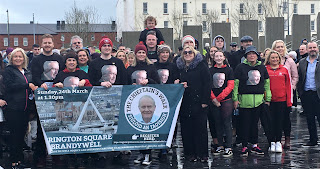
THE CHIEFTAINS WALK.
The Chieftains Walk will be on Sunday 18th September at 1pm in Derry. It is in memory of Martin McGuinness. So why not join us and Martin’s family. The walk is organised by The Martin McGuinness Peace Foundation. The foundation was established in September 2019, two years after Martin’s death.
The objects of the Foundation are;
To celebrate the life and achievements of Martin McGuinness, as a leader, a political activist and an international statesperson. The Foundation is established for charitable purposes only and in particular to carry out charitable activities for the public benefit in the areas of:
• The advancement of reconciliation, conflict resolution, unity and peace building - locally, nationally and internationally;
• Community empowerment;
• The advancement of human rights, and;
• The advancement of equality, inclusivity and diversity.
Since its inception the Foundation has organised a number of events around reconciliation as well as an online concert marking Martin’s 70th birthday.
The Foundation also organises annual events which include the Chieftain’s Walk, a Gaelic Games Blitz and a Fly-Fishing competition. This year the Foundation, in recognition of Martin’s passion about the importance of education and employment, has introduced a bursary scheme to help people build better futures for themselves and their families.
The Chieftain’s Walk has been disrupted over the last few years due to Covid restrictions but this year, with restrictions lifted, the Foundation is looking forward to seeing the return of the hundreds of people who have previously participated in the Walk joining us as we remember our Chieftain.
The proceeds of the Chieftain’s Walk will go to help support the work of the Foundation and I want to encourage everyone to sign up at www.register.enthuse.com/ps/event/ChieftainsWalk2022
The route of the Walk will be from Martin’s home, down Westland Street, along Rossville Street, William Street, Waterloo Place, Guildhall Square, Shipquay Street, around the Diamond, up Bishop Street and onto the Derry Walls via Stable Lane. The Walk will then proceed around the Walls in an anti clockwise route, coming off at Magazine Street, proceed through Butcher Gate and down Fahan Street, and out through Rossville Street and the Lecky Road to the Long Tower Centre.
Chieftains Walk New York.
If you live in New York or you happen to be there on September 18 you can play your part by joining in the New York Chieftain’s Walk assembling at the Irish Hunger Memorial in Battery Park City at 10.00am on September 18, 2022.
You may also want to attend the inaugural Martin McGuinness Peace Foundation Dinner in the Manhattan Manor on the evening of September 21st. You will be very welcome. Details are available on the Foundation’s Website and social media platforms.
admin@martinmcguinnesspeacefoundation.org
September 5, 2022
The Belfast Peoples Assembly: Prison Privilges
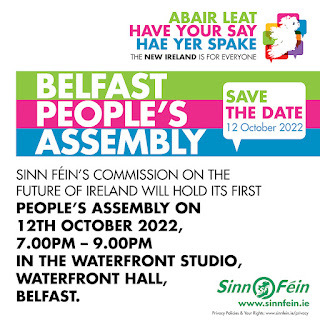
The Belfast Peoples Assembly
Hardly a week passes now without politicians, bloggers and columnists writing about Irish unity and calling on the Dublin government to establish a Citizens’ Assembly to plan constitutional change. The number of books and informed academic publications examining and supporting constitutional change have also dramatically increased.
Under the banner ‘Together We Can’ Ireland’s Future is busy promoting their major conference in the 3 Arena in Dublin on 1 October. Their impressive line-up includes political and community leaders, artists, and international guests. The group also plans to launch a ‘vision document’ setting out their view of the future.
Last summer Sinn Féin announced the setting up of a ‘Commission on the Future of Ireland.’ The Commission is a unique and ambitious initiative which includes a series of Peoples’ Assemblies under the broad slogan - ‘The New Ireland is for Everyone – Have Your Say.’
On 12 October - the inaugural first public meeting of the People’s Assembly will take place in Belfast’s Waterfront Hall between 7 and 9pm.
The Commission is extending an open invitation to all citizens and sections of society to submit their views on the future of Ireland. The opinions of those with alternative visions for the future are also welcome. There will also be Women’s Assemblies, Youth Assemblies and Assemblies in Gaeltacht areas. The intention is to widen the current conversation through public, sectoral and private discussions.
The Commission will seek to engage with the protestant and unionist sections of our people. Our neighbours with a British identity, and the unionist, Protestant and loyalist members of our community are especially welcome to participate.
If you would like to attend the Belfast Assembly you can register for it at www.eventbrite.ie
Submissions to the Commission on the Future of Ireland are open at www.sinnfein.ie/futureofireland
Prison Privileges.
On my occasional vacations at her majesty’s pleasure many of my comrades made mementos of their incarcerations from wood or leather as gifts for family or friends or for The Green Cross or An Cumann Cabhrach, the prisoner’s dependents support groups. I rarely did any handicraft work. I lacked the skill sets required. In the beginning my artistic endeavours were limited to the production of handkerchiefs suitably adorned with pledges of everlasting love with appropriate symbols. All brightly coloured with markers. Some were for birthdays, or anniversaries. Some were for children and were replete with cartoon characters. Mickey Mouse and Donald Duck were favourites. Other prisoners painted illustrated and defiant statements of revolutionary intent. Armalites featured alongside Tricolours and Starry Ploughs. Or drawings of our patriot dead.
Leather work was also popular. Purses and wallets. Belts. Handbags. Celtic art work adorned these. And the name of the recipient. I never did any leather work but by way of bribery or barter I did manage to gift Colette some lovely and fashionable accoutrements. Some fine craftsmen emerged, particularly from the cages of Long Kesh. The late Tom Cahill, despite injuries inflicted on him in a gun attack, was a particularly accomplished leather worker.
Woodwork too was the demesne of highly talented crafts men. Especially country men. That is anyone outside Belfast. They produced Harps and Celtic Crosses. Of all sizes. Some very large indeed. If I remember correctly there is a full size harp on display in Cumann na Meirleach - The Felons Club. Alongside a rocking chair. Spinning wheels were also very popular. I did a small Celtic cross once. I have it yet. I was unsure of how to reproduce the appropriate Celtic designs to adorn its panels. Ted persuaded me that he was an expert in fourth century Ogham symbols. He told me he had studied this ancient and primitive form of Irish writing. I was very gullible. I still am. And Ted is very persuasive. He still is. He drew the symbols free hand on my wee cross and I dutifully carved them out. They are very unique. I have carried that cross for Ireland and Ted since our sojourns in Cage Six fifty years ago.
Music boxes of all kinds, from little pianos to wooden hearts also emerged. All finely engraved with iconic romantic images, names and proper celtic designs. Some had musical chimes which played when the box was opened. That’s why they are called music boxes I suppose. Some had plush interiors. They were lined with velvet of a suitably rich texture and colour. I used to slip a wee note - This music box was made by Gerry Adams with the date - beneath the lining when the music box maker was otherwise engaged. I thought it would be funny decades later for someone to discover who really made their much treasured vanity set. .
Joe Rafter - Floorboards - specialised in making models of the Travelling people’s barrel shaped covered wagons. Other comrades produced plaques for all occasions. At times there were passing fads. For example lollipop sticks or match sticks were glued together to construct - yes you’ve guessed it- harps and crosses. But these were never as popular as the wooden ones. I suppose it was easier to get wood. Match sticks or lollipop sticks were less available, particularly in the thousands that are needed to make a decent sized piece of craft. Occasionally some enterprising folks would shape coins into claddagh rings. I think Seanadóir Niall Ó Donnghaile has a Fáinne made by one of his imprisoned ancestors.
Once I got a very fine wooden garage made for our oldest lad. It was painted white and its signage was Adams And Son. There was a ramp going to the flat roofed car parking space for all his wee dinky cars. I was very proud of it. Someone stole it from outside our door down in Harrogate Street. Tom Hartley lived across from us. Number one suspect?
The oldest lad also got a wee wooden sword in its own scabbard and a wee belt. Now the oldest lad’s oldest lad has it. Although the handle is broken. But still. It is half a century old after all.
Under prison regulations handicraft work is described as a privilege. Sometimes privileges would be withdrawn by the prison regime. This usually caused uproar. During the blanket protests the men in the H Blocks were denied all of their privileges. The women in Armagh suffered similar sanctions.
There were also many fine artists among us. Pat Magee was very good. So too was Danny Devenney, Lucas Quiqley and his brother Tommy. On the Maidstone Prison Ship I was moved for a wee while to dabble in watercolours. I am including my best piece here. Gerard Davidson was my mentor. This wee yoke lay rolled up in our attic for decades. It looks far better framed and on the wall, where it belongs. A reminder of The Maidstone. We forced them to close this prison ship down by the way. But that’s another story.
Tom Hartley is always on the look-out for prison handicrafts. A piece I gave him from Armagh Women’s Prison has pride of place in the Ulster Museum. It used to belong to the late Kathleen Thompson. The Armagh women sent it out to her in thanks for all her work on behalf of prisoners. Maybe you have some hidden treasures in your glory hole. Or on the top of the wardrobe. Or in the garage. Or in your Granny’s bottom drawer. Have a look. You never know what you might find. These wee pieces of handicraft work are all part of our community, family and national history. They are a reminder of our penal history. And they helped some of us to do our whack.
August 29, 2022
The Troubles I’ve Seen; An Dream Dearg - Cearta Teanga; National Hunger Strike March
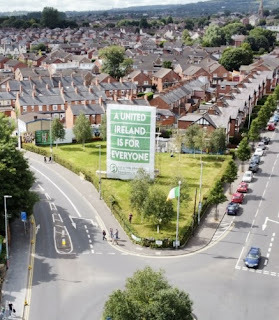
The Troubles I’ve Seen
During the Féile I went to watch The Troubles I’ve Seen in Áras Úi Chonghaile. I’m glad I did. The Troubles I’ve Seen is a documentary which is being shown across the North. The LGBT NI Heritage Project is very keen to get it into local areas. The documentary captures the shared experiences and stories of the local LGBT Community.
Directed by Conan McIvor, this emotive and often funny film hears from those who experienced and were involved in the beginning of the LGBT movement. They delve deeply into how their pride and fearlessness helped them overcome the shame and harassment levelled at them by elements of society.
With contributions from activists such as Jeffrey Dudgeon, Doug Sobey, Paula Keenan and more, The Troubles I’ve Seen explores the start of the Gay Liberation movement and the establishment of Cara-Friend. It looks into the deep sense of community and support that was forged by campaigning in the face of AIDS, legal restrictions, and the repressive political situation.
The LGBT NI Heritage Project is a collaboration between the three main LGBT Sector Groups; Here NI, The Rainbow Project and Cara-Friend. They are funded by the Heritage Lottery as well as Belfast City council. The project looks at a snapshot of local LGBT History between the years of decriminalisation and the introduction of section 75. (1980 -1997)
The LGBT NI Heritage Project employs a coordinator but it is very much a volunteer led project, with 15 active volunteers.
It has a monthly LGBT History Club online in conjunction with the Linenhall Library, captures stories, articles, photos and items for its online archive and exhibitions.
It runs an LGBT Heritage walking tour called Places of Pride and has also worked with PRONI on some of their projects.
Mary Ellen Campbell is Co-ordinator of LGBT Heritage Project. If you are interested in this work, if you need help or if you can host a viewing of The Troubles I’ve Seen contact LGBT Heritage Project and Mary Ellen at history@hereni.org or at HERe NI
1st Floor, 23-31 Waring Street; Belfast; BT1 2DX
An Dream Dearg - Cearta Teanga.
Last May with some 20,000 others, I attended the Lá Dearg rally in Belfast. This event was organised by An Dream Dearg in response to the continuous delay in implementing the long-promised Acht Gaeilge. It was a great day out. Despite the understandable frustration and anger among the Irish language community, the atmosphere of the day was one of celebration, of positivity and inspiration.
There was a singing, chanting sea of red draped gaelgeoirí all along the Falls and into the city centre. Oul lads, old ladies, family groups, teenagers, middle aged couples. And children. Tons and tons and tons of bright eyed excited paistí chanting ‘Dearg le Fearg.’ Gaels galore. All determined and cheerfully facing the future.
It was also obvious from the platform speeches that the organisers were already planning their next initiatives.
Féile an Phobail saw the first manifestation of this. The campaign group hosted the launch of their lámhleabhar chearta teanga (language rights handbook). The handbook examines the challenges and opportunities posed by the incoming Acht Gaeilge. It gives an overview of the most significant changes that a community whose rights have been denied for so long, should expect and be entitled to.
The launch was complimented by an all-female panel discussion with five activists giving fascinating accounts of the trials and tribulations that they have faced on their respective journeys. All of them are former pupils of Gaelscoileanna, who have used their experience of fighting for their basic rights in actively demanding better for future generations. Ábhar mór dóchais. I was delighted to be in the audience and to be uplifted by the passion, clarity of thinking and strategising of these leaders.
Earlier that day, I was told that the same group had launched their new website. Fittingly named dearg.ie, the site centralises community voices and connects local people with decision makers. It informs them of their council’s current bilingual street signage policy, policies which often place unjustifiable obstacles in the way of those who wish to see their native language on signage. The site informs and encourages users to apply, or to challenge or to demand better, based on their council’s current provision.
The work of language rights activists right across the north is proving transformational in solidifying the message that Pobal na Gaeilge are no longer willing to be treated as second class citizens in the North and that the days of hear no Irish, see no Irish, speak no Irish are a thing of the past.
Over the next number of months Irish language legislation will progress through the British House of Commons on its legislative journey. However, after listening to those women on the panel there is no doubt that this is only the beginning for them. What has been achieved so far has been achieved without an Acht. So the future is bright. I have great confidence in those who are helping to shape it. There is still plenty to do for cearta teanga here in the North and indeed across the island. But it is clear that Dream Dearg's campaign will continue until the long awaited promise of rights, recognition and respect are fulfilled. Maith sibh!
The Lámhleabhar sets out some of the actions that can be taken now to advance language rights. These include:
· Apply for a bilingual street sign in your area
· Challenge local councils to ensure that they are providing services to Irish speakers.
· Use the power of social media
· Support language campaigns
· Don’t sit around and wait. Act now!
It provides clear instructions on how each of these can be used. The Lámhleabhar Chearta Teanga can be accessed on the Dream Dearg website in Irish and English on the new Dream Dearg website www.dearg.ie
National Hunger Strike March
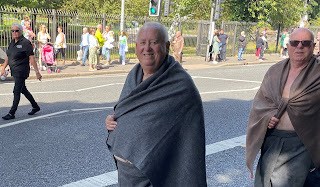
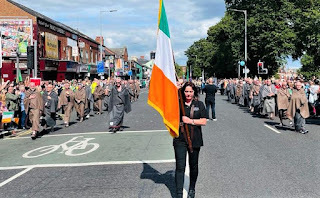
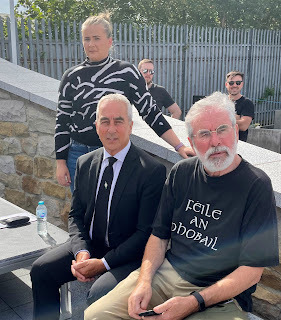
Comhgairdheas to all of those who organised and participated in the Belfast march on 21 August to remember the hunger strikers of this and previous phases of struggle. Thousands came from all over Ireland to take part. I met comrades from Meath and Mayo and Dublin and Derry. The families of the hunger strikers had pride of place and many former blanketmen – wearing their grey blankets – and Armagh Women POWs helped lead the event.
At the Republican Plot in Milltown Cemetery former hunger striker Pat Sheehan gave a moving personal account of his time on the blanket, of his decision to go on hunger strike and he reflected on the courage of the hunger strikers who died and of the enormous political impact of the hunger strike.
He reminded us that the criminalisation policy of the British was to defeat Irish republicanism. “So how has that worked out?” he asked.
“The Orange state has gone.
Unionist domination has gone.
Sinn Féin is the biggest party in the North and on the island of Ireland.
Criminalisation was defeated and the injustice of partition and the British state in Ireland was exposed to international scrutiny as never before. By their heroism and sacrifice the hunger strikers ensured that the cause of Irish freedom was renewed and that now in 2022 we are closer than ever to undoing the injustice of partition and reuniting our country. Their bravery set in train a series of events that makes the momentum for political and social change unstoppable and irreversible.
That momentum will carry us forward to the realisation of an Irish national democracy. A republic where the rights and identity of all our people, of whatever persuasion or background, will be accommodated and cherished.”
Gerry Adams's Blog
- Gerry Adams's profile
- 29 followers


